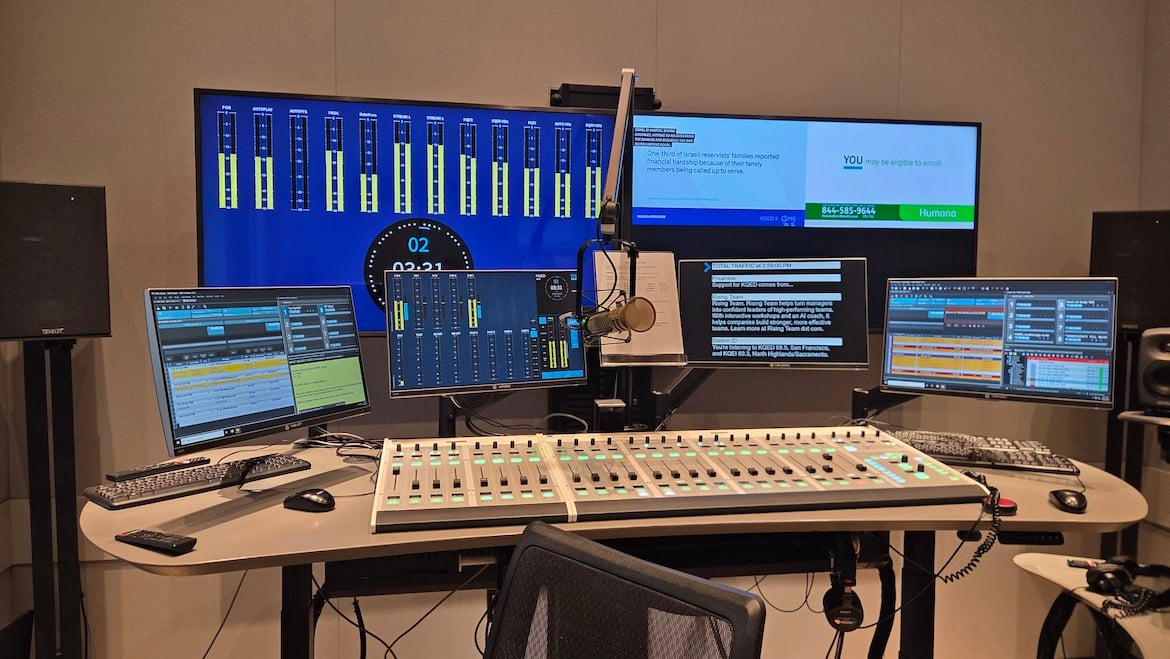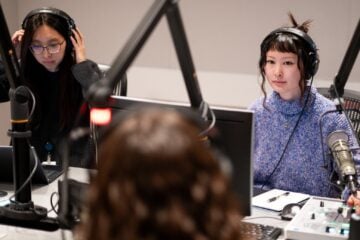Playbook for growth: Treat radio like a vibrant platform and your audience will flourish

Ernesto Aguilar
When Inside Radio reported Nielsen ratings that ranked KQED as America’s number-one news/talk station, it was a gratifying moment — not just because of the achievement, but because of how far our entire team had to climb to get here.
Like so many public radio stations, KQED faced a sharp decline in listening in 2023. As the staff member leading radio at KQED, the downturn was as stressful for me as it was perplexing. Audience losses challenged long-held assumptions about loyalty, reach and relevance. For an organization that had invested heavily in journalism, community engagement and digital expansion, the decline raised an uncomfortable question I’d previously heard but dismissed: what if public radio’s best days were behind it?
KQED’s programming team refused to accept that premise. Instead, the executive leadership team stood up an internal working group in July 2023 to diagnose the problem and make recommendations on how to rebuild radio listenership. What followed was not just a programming tweak or a marketing blitz, but a multi-department change management effort that forced us to rethink how KQED uses airtime, how it presents content to the listener, and how its promotions serve audiences in the middle of a relentless news cycle.
This is not a victory lap. It’s a playbook of ideas you can use and lessons you can apply. These are the strategies that helped us stem the tide of doubt about public radio’s future.
Think beyond Nielsen and news cycles
Changes to Nielsen’s audience methodology, which now counts each listener who tunes in for a minimum of three minutes, have provided some lift for news/talk stations and music formats. A Radio Research Consortium analysis of 45 PPM markets from the Winter 2025 survey indicated large gains in time spent listening, while cume also saw growth of about 3%. In addition, people using metered media (PUMM) increased by 16% percent.
For news/talk stations, whose audiences often drop in and out around headlines, that change is important. But it’s not the whole story.
If the three-minute qualifier and an intense news cycle were all it took to lift listening, then every news/talk station in America would be topping its local market. Yet that isn’t what the Nielsen data show. In most markets, only a handful of stations have maintained or grown share since the new measurement began. Inside Radio’s own monthly summaries, along with NPR’s aggregated PPM analyses, show wide variance across markets. The difference isn’t the news cycle; it’s how stations program within it.
Public radio listeners are loyal, listen for long periods and crave context. We ask ourselves in programming: how can every moment be more compelling so listeners will stay with the station longer? For KQED, that meant making sure that, whenever someone tunes in, the coverage feels alive, local and urgent.
The news cycles of 2025 gave public radio plenty of practice. From national politics to regional crises, KQED’s newsroom built its muscle for putting a local scope on the news while not overloading the audience. The newsroom understands that listeners don’t just want to know what’s happening. They come to public radio for context, clarity and connection. They also want new lengths and formats. Public radio’s aspiration should always be to surprise listeners. Centering audience needs, as the 2024 Researching Unmet Needs study indicates, helps public radio keep listeners past the three-minute mark.
Promos: Unsung heroes of radio habit
One of the major areas identified for attention was the time KQED had for local cutaways. If airtime is public radio’s most precious commodity, then promotions are the best way to invest it. On-air promotion is critical for building listening habits and shaping how audiences perceive radio. As such, the programming team puts a great emphasis on fostering both.
At KQED, the programming team has two main goals for promotions:
- Driving audience behavior. These are action-oriented messages, prompting listeners to engage further with the station: “Stay tuned for …,” “Listen tomorrow when …,” “Find more on our app.” They keep people listening longer and push them toward digital touchpoints. Many stations use these messages to forward-promote what’s coming in the next hour. I’m an advocate for messages that put your web content, podcasts and other avenues for engagement in front of listeners more often. I understand some programmers believe this encourages people to tune out, but in my experience it has the opposite effect. My goal is to use radio — the biggest platform KQED has — to keep the station front of mind for the audience.
- Influencing audience perception. These promos work to create an emotional connection with KQED’s brand. Commercial radio calls them “imaging” messages; in public radio, “positioners” like “Live and Local” or “NPR for [area]” were once popular. Last year, KQED focused on-air positioning squarely on the biggest value proposition: KQED News. This messaging puts the newsroom front and center and reminds listeners that, when a big story breaks, KQED has the information and context they’re looking for.
Both types of promotion matter, and the balance between them is deliberate.
Organizations like the Public Media Content Collective (formerly PRPD) have long taught the four core promotion techniques: forward, vertical, horizontal and diagonal. The KQED programming team uses them all to varying degrees:
- Forward promotion tells the listener what’s coming later today
- Vertical promotion ties into what’s on right now
- Horizontal promotion connects days of the week
- Diagonal promotion leaps across programs to build surprising connections
How you apply them at your station is up to you, but I encourage you to experiment, listen to audience feedback and monitor your listenership numbers closely. These methods are not just abstract theory. They are habits that keep audiences hooked and make sure they come back tomorrow.
Airtime is finite. Manage it ruthlessly.
One of the biggest cultural shifts the programming team undertook (and helped other departments understand more) was treating airtime like a scarce resource. Every bit of content, promo and interstitial carries an opportunity cost. A station can influence the listener’s habit and perception when it offers up local content, and it is important to center that clarity.
Programming holds a culture of inventory management that sets clear limits and priorities. How could your station do this? One approach is establishing the following:
- A hierarchy of promotional priorities
- Realistic frequency levels that respect audience attention
- Cross-department coordination to avoid clutter and duplication
The result isn’t just cleaner air. It is a clearer sense of identity. Audiences aren’t bombarded. They are guided.
Collaborative decision-making
Behind the scenes, this work required more than scheduling tweaks. It was a change management process across multiple departments. If your content staff is passionate about growth and evolving, include them in your radio efforts. Welcome new ideas. Praise on-air people who bring something fresh to the table and the mic.
By embracing new approaches, these fresh concepts have bloomed at KQED:
- To better serve drop-in listeners with local news, the morning news team adjusted how it uses that small space in the Morning Edition billboard to mention local coverage.
- Programming refocused promo inventory around listening occasions — for example, making sure morning drive promos leaned into news urgency. We also matched the type of promotion to the moment: forward promos during Morning Edition to keep people through the top of the hour; horizontal promos, inserted sparingly, encourage tune-in. Those clearer rules created balance on air, kept us from overloading listeners and gave staff a shared framework for deciding what made it into rotation.
- The Programming and Development teams collaborated on creating new appeals in different lengths and sounds, like emphasizing urgency during morning drive. Programming also opened up to airing more appeals across the day to support targeted member email.
Decisions about these changes were not top-down — they were collaborative. And that mattered, because when staff buy in, they carry the strategy through in subtle but powerful ways.
What we learned (and ideas you can steal)
Every station has its own market, culture and constraints. But some lessons are universal:
- Don’t treat Nielsen changes or the news cycle as a get-out-of-jail-free pass. Demand for news and bumps in ratings can be fleeting. Ask how you can make listening more sticky.
- Audit your promos. Do they drive behavior, shape perception or neither? Be intentional about all those moments.
- Limit clutter. Fewer, stronger messages beat a barrage of weak ones. And dump the “evergreen” spots that have been around more than a month or two. Chances are your audience heard them and is tuning out.
- Rethink your positioning. What’s your core value proposition today? If your imaging is from 10 years ago, it’s likely your audience has outgrown it.
- Invest in human connections. Even short-form, unscripted content can refresh the listener relationship in surprising ways. KQED’s new Trusted Voice Content — unscripted, organic short-form spots intended to bring listeners closer to the KQED reporters and personalities they value — refreshes the listener relationship in surprising ways.
Decline is not destiny
There is much more to the KQED story. From advertising to signal improvements to going direct to the listener with our app, teams across the organization devoted time and effort to supporting radio. Perhaps the most important lesson is this: decline is not destiny.
It is easy, in an era of podcasts and digital-first strategies, to assume that radio is fading. But KQED’s experience tells another story. When public media treats radio as a living platform, when stations breathe creativity into airtime, audiences respond.
Being named the number-one news/talk station in the country is gratifying. But what matters more is knowing that our audience service has improved. The strategies in our playbook are replicable. Your station, no matter its size, can apply them too.

Radio is still the heartbeat of public media. If public media manages it with care, discipline and imagination, it can be the runway that carries us into the future.
Ernesto Aguilar oversees radio broadcast content and innovation initiatives in the Content division at KQED in San Francisco. Prior to KQED, Aguilar served as executive director of the National Federation of Community Broadcasters. In his spare time, he writes OIGO, a newsletter on public media and Latino audiences, and AI and Public Media Futures, a newsletter on artificial intelligence’s impact on public broadcasting.
Correction: An earlier version of this commentary misstated the date that KQED appointed the working group that developed new strategies for rebuilding radio listenership. It was July 2023, not July 2021.







This is a fine article from Ernesto, and I love what he’s saying. But it chills me to think that so many people are finding this “revolutionary” thinking when really it’s just paying attention to a (relatively) small part of the basic fundaments on how to do good radio.
Has public RADIO really shoved its collective heads so far up the rear end of podcasting that nobody is left in public RADIO who understands the fundamentals of RADIO broadcasting and how make good RADIO that works on RADIO stations trying to attract a RADIO audience?
Hint: I’ve left a giant dollop of bait and I’m pretty sure someone will take it. Before it’s you, think hard about why there’s so many examples that disprove what you’re about to write.